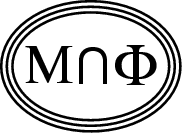
Back to
OP page
Combined
List
List by
Contributors
 Back to OP page Combined List List by Contributors |
Soft phases in two-dimensional O(N) models.Contributed by: A. Patrascioiu (Univ. Arizona) and E. Seiler (Max Planck Inst. Munich), March 11, 1999.Abstract Do the spin correlations in the classical Heisenberg model, and other O(N) models with N>2, decay exponentially at all non-zero temperatures, or do the models have soft phases akin to that of the XY model? |
It is generally believed by the statistical mechanics and quantum field communities that, unlike the xy-model, the classical Heisenberg O(N) model has exponentially decaying correlations at all temperatures. This belief is based mostly on formal perturbation theory (= low temperature expansion) [1,2]. While for the xy model it has been shown by Bricmont et al [3] that this expansion is indeed the correct asymptotic expansion in the thermodynamic limit, a proof for the classical Heisenberg model does not exist.
The conventional picture has been challenged by us and we have proposed that the model (and indeed all O(N) models) has a transition to a soft phase with algebraic decay of correlations at low temperature. We gave arguments based on percolation theory [4] and on the structure of low-lying excitations (super-instantons) [5]; we discussed the weaknesses of the conventional arguments in [6].
The problem is of great significance for particle physics, because the classical Heisenberg model is a toy version of QCD, the theory of strong interactions. Existence of a soft phase also in QCD would most likely imply failure of the so-called asymptotic freedom.